Update (March 28th): TOC added, locking down Hungary, and a Hungarian translation is available.
11 190 people read the article so far, thank you for all the positive feedback 🙏
After 1.5 weeks of non-stop research, I made a 7,100 words summary of the global situation.
Keep on reading to understand:
1) what does the SARS-CoV-2 virus do, so we don't fear the unknown
2) why officially diagnosed case numbers are off, even with extensive testing
3) what individuals can do
4) what individuals shouldn't do
5) best practices of successful countries
6) worst practices of unsuccessful countries
7) how things unfold in affected countries
8) possible endgames
9) my personal experience in Budapest, Hungary
If you don't feel that your leaders acted TOO EARLY and TOO AGGRESSIVELY, then you are probably in a region with a 5% mortality rate, rather than 0.5%.
We should act while we can.
Most important:
- STAY HOME
- WASH YOUR HANDS with SOAP
- if not feeling well, CALL your doctor, DON'T GO to the hospital to infect others and get infected
- EDUCATE your family members at risk; you have to take responsibility
- if you are a healthcare professional, join this Facebook group to exchange important information, eg. how to increase ventilator capacity by 3-9x, sterilize FFP2 masks, etc.
Share this article, and tell why others should read it.
Perfect weather, the sun gently caresses my skin, and the white sand under my barefoot is hot enough to feel relaxing. All neighboring islands have already hit by the approaching typhoon, but here I can only sense the lull before the storm.
If Hungary were a tropical island, this is how it must have been felt at the beginning of March 2020. All neighboring countries started to panic, and all I could feel is silence and skepticism.
I attended Stanford's on-campus one-week Innovative Healthcare Leader program two years ago, which gives me connections to a diverse set of healthcare leaders, and a unique perspective about the current SARS-CoV-2 epidemic.
On March 15th, I got this message from a hospital executive in the Netherlands, detailing how their healthcare system is over capacity only 2.5 weeks after the first case was confirmed:
Note: I'm not a doctor, this is not medical advice, you should always follow the guidance of authorities, this piece was originally intended only for my family and close friends as summarizing the most trusted resources about the topic.
Summary of events
“Compound interest is the 8th wonder of the world. He who understands it, earns it. He who doesn't, pays it.” - attributed to Albert Einstein
"The greatest shortcoming of the human race is our inability to understand the exponential function." - Albert Allen Bartlett
Humans didn't evolve to see exponential processes, and now everyone pays the price. We can intellectually understand the thought experiment of a bacterium doubling every minute within a bottle, which becomes full at 60 minutes, so it was half-full at 59 minutes, not 30. But it is not intuitive, we're still longing for and looking for a new bottle, which would last only 1 more minute. Wishful thinking is not a strategy. This pandemic is exponential, and the reserves in our healthcare systems are finite, so the only viable strategy is to overreact early on when it "doesn't make sense" and "experts say that it is irrational".
Considering this fundamental human blind-spot on a hardware level, it is not that surprising that events unfold in a universal order in the western hemisphere:
- general disbelief, calling it a hysteria
- few cases roll in
- ambulance siren becomes frequent
- people small scale panic about toilette paper and food, supermarkets remain stocked
- social media posts about food
- people think that a hotter climate helps
- people realize that Malaysia, with its hot climate, is hit the same [R] by the pandemic
- hospital corridors suddenly get overcrowded
- doctors have to decide who gets oxygen thus live
- doctors work around the clock, exhausted, and get sick, some die
- doctors feel left alone, without proper protection or clear information
- people feel lied to, there are much more cases than reported, even with extensive testing, since it takes 2 weeks for symptoms to worsen thus getting diagnosed
- diagnosed cases explode, people act surprised, not understanding that the diagnosed number is two-week old data on an exponential curve
- people are restricted in movement: which IS CRITICAL to WIN this war
- people die from the virus
- people die from preventable causes (eg. injury), the healthcare system is saturated
- military escorts out dead bodies from apartments
- social media posts about people dying
- financial markets drop, people act late, then overreact
- ambulances become silent to lessen the fear
- pharmacies and supermarkets remain open
- people feel depressed in isolation
- COVID-19 divorces skyrocket
- people turn to play music to cheer up neighborhoods
- people with jobs got used to working from home, more efficient, less commute
- people without jobs and savings feel despair and the pain of readjustment
- eventually, people start to go back to the streets and go to work
- people fear of a new wave of infections imported back from abroad: currently (as of March 16th) in China and Hong Kong
- bankruptcies on the personal, family, company and national level
- COVID-19 boomers born in 2020 December and 2021 January
- people keep calling global warming a hysteria, still don't understand non-linear processes (locust swarms in Africa?)
Visual Summary
Social distancing works, STAY HOME. You can go to fresh air, keep 2+ meters distance to people:
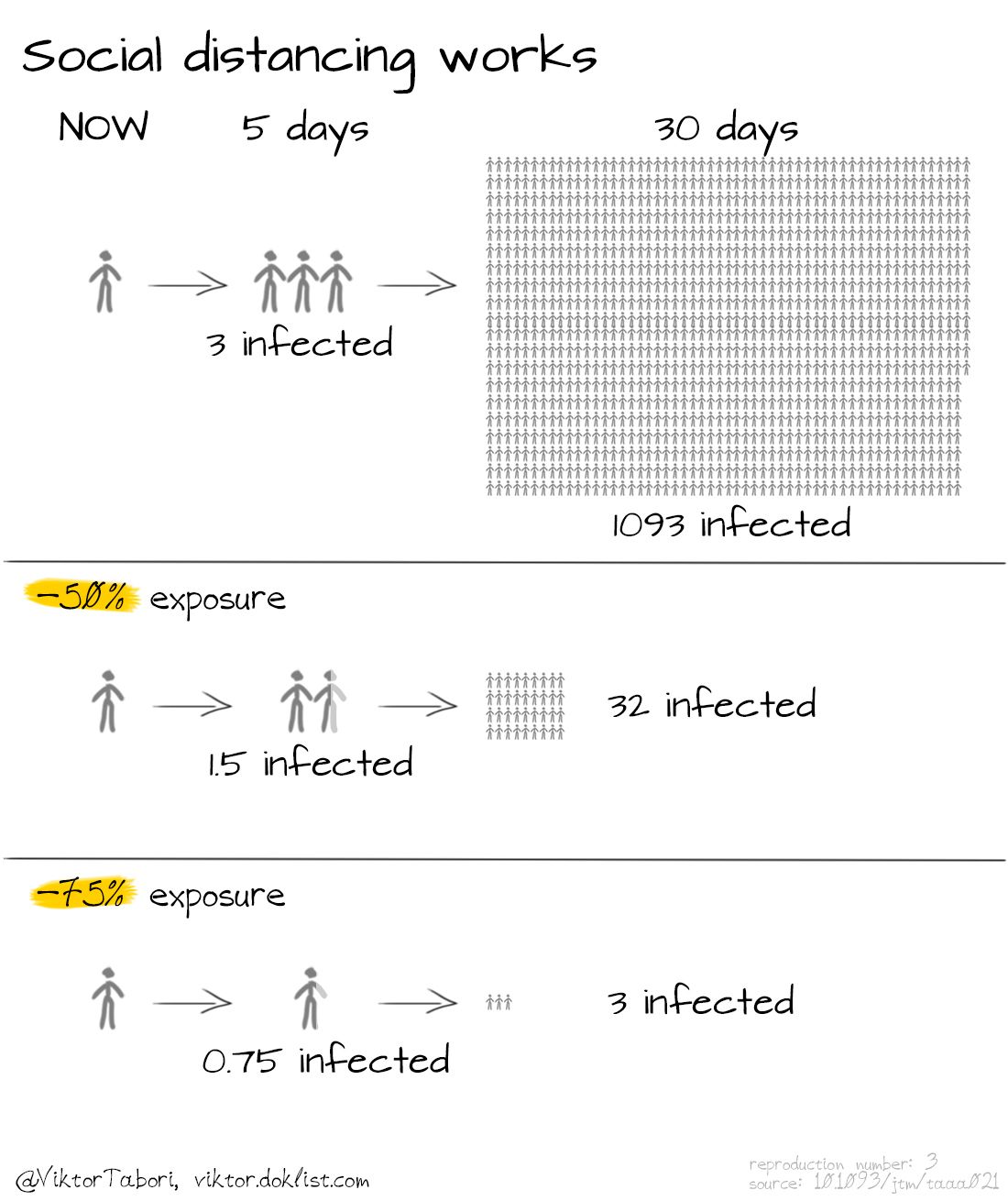
NOT everyone gets infected. Cruise tour participants are not considered to be among the youngest and healthiest, still 81% of people on Diamond Princess Cruise [R], and 80% of highly exposed Italian doctors DIDN'T get infected [R]:
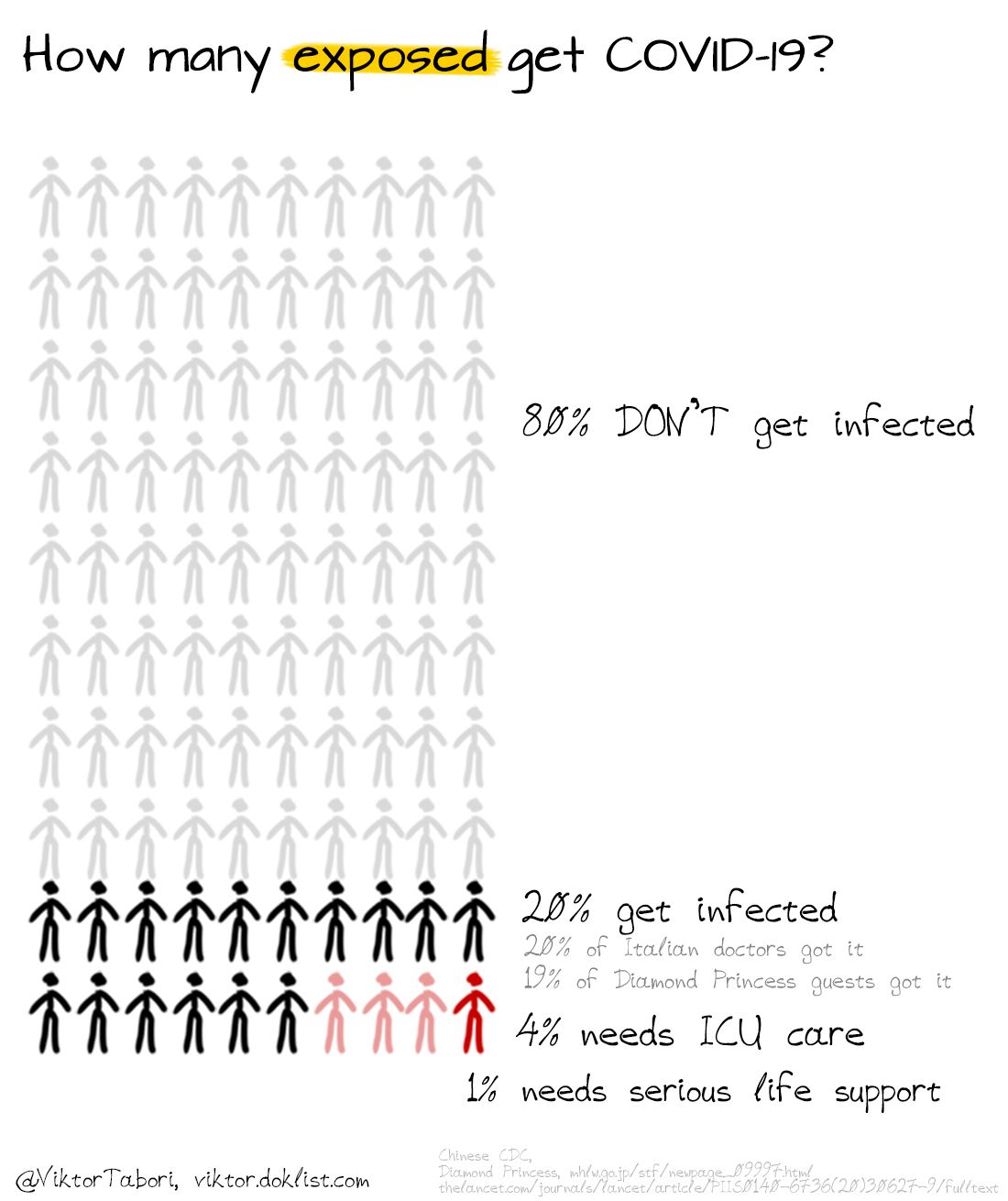
We should act NOW. Strict and prompt lockdown is the difference between 3,500 vs 2,400,000 dead in a 60M region. You can play with this epidemic calculator.
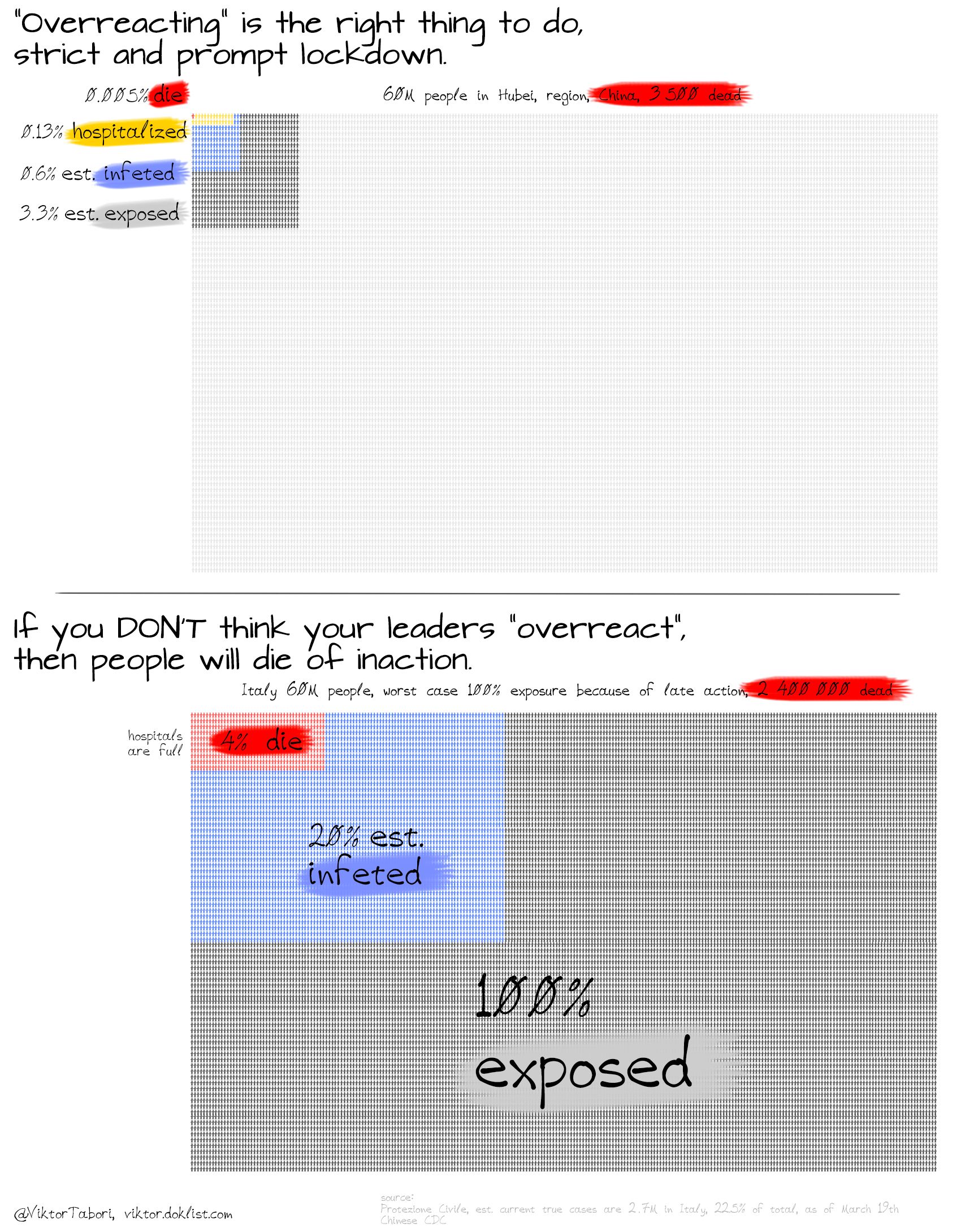
China stopped the spread with an early and aggressive lockdown. Soft and late actions lead to people dying unnecessarily:
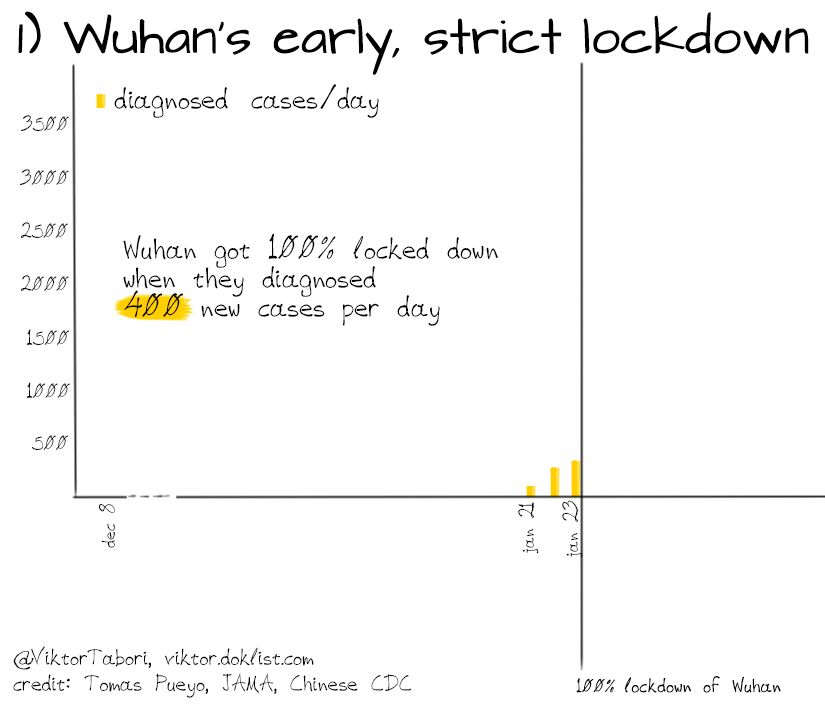
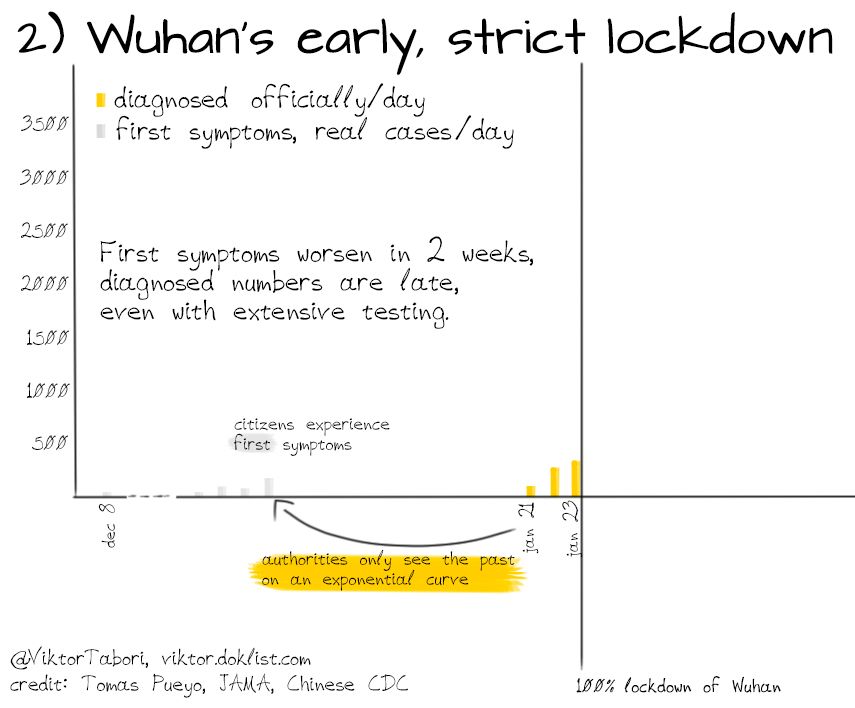
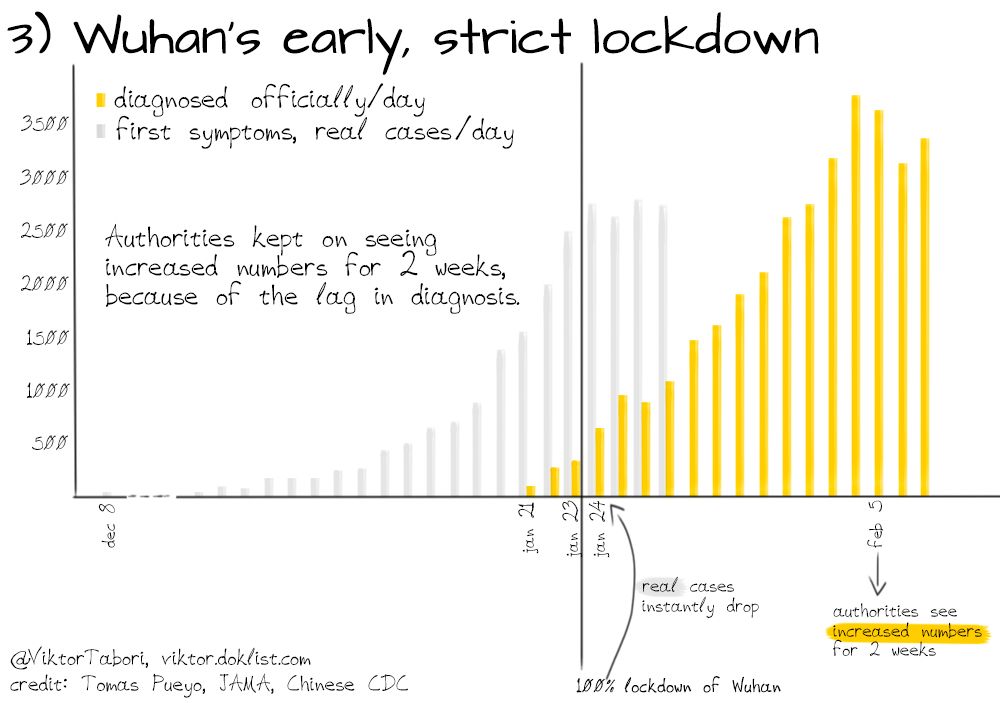
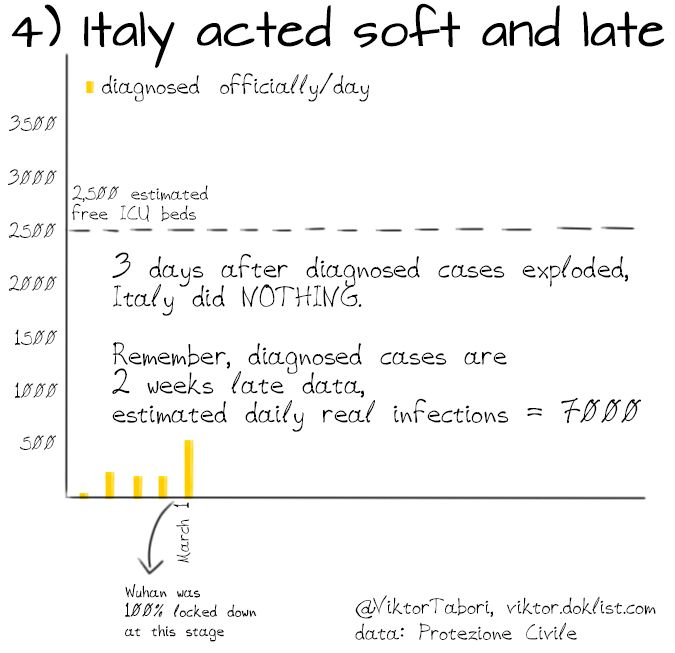
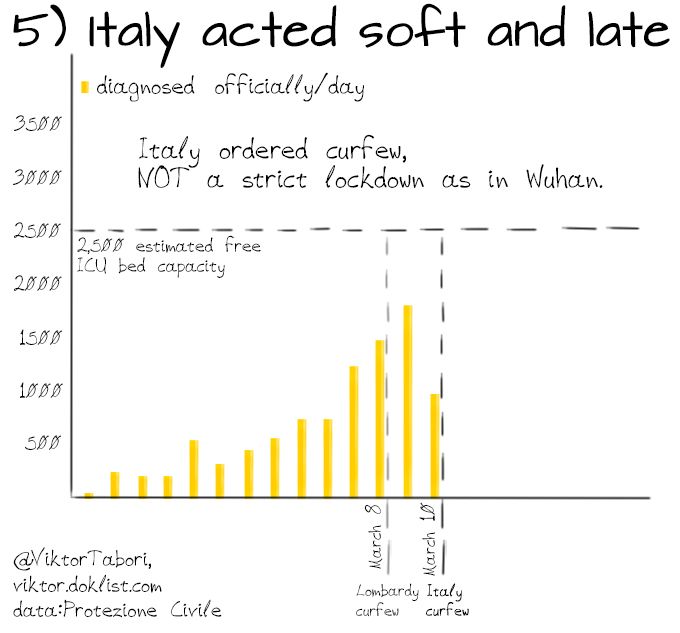
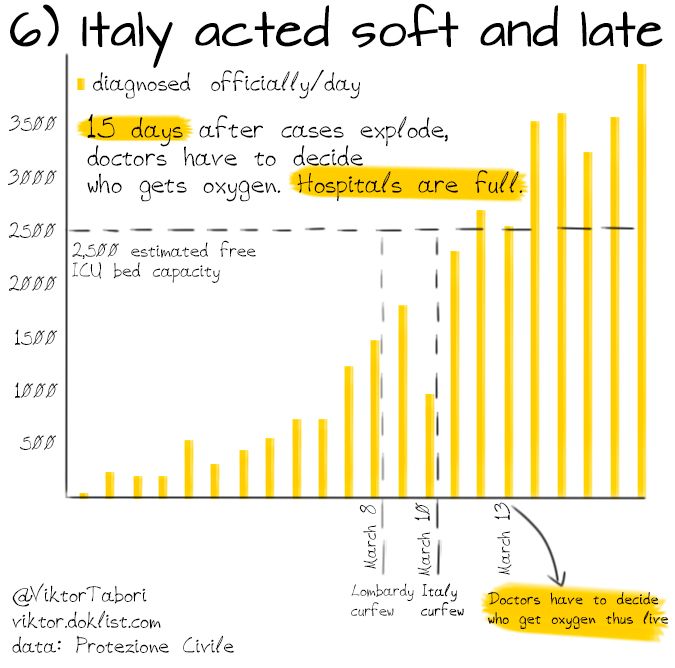
Main risk: high hospitalization rate overwhelms the healthcare system, so people die on hospital corridors, who could have been saved:
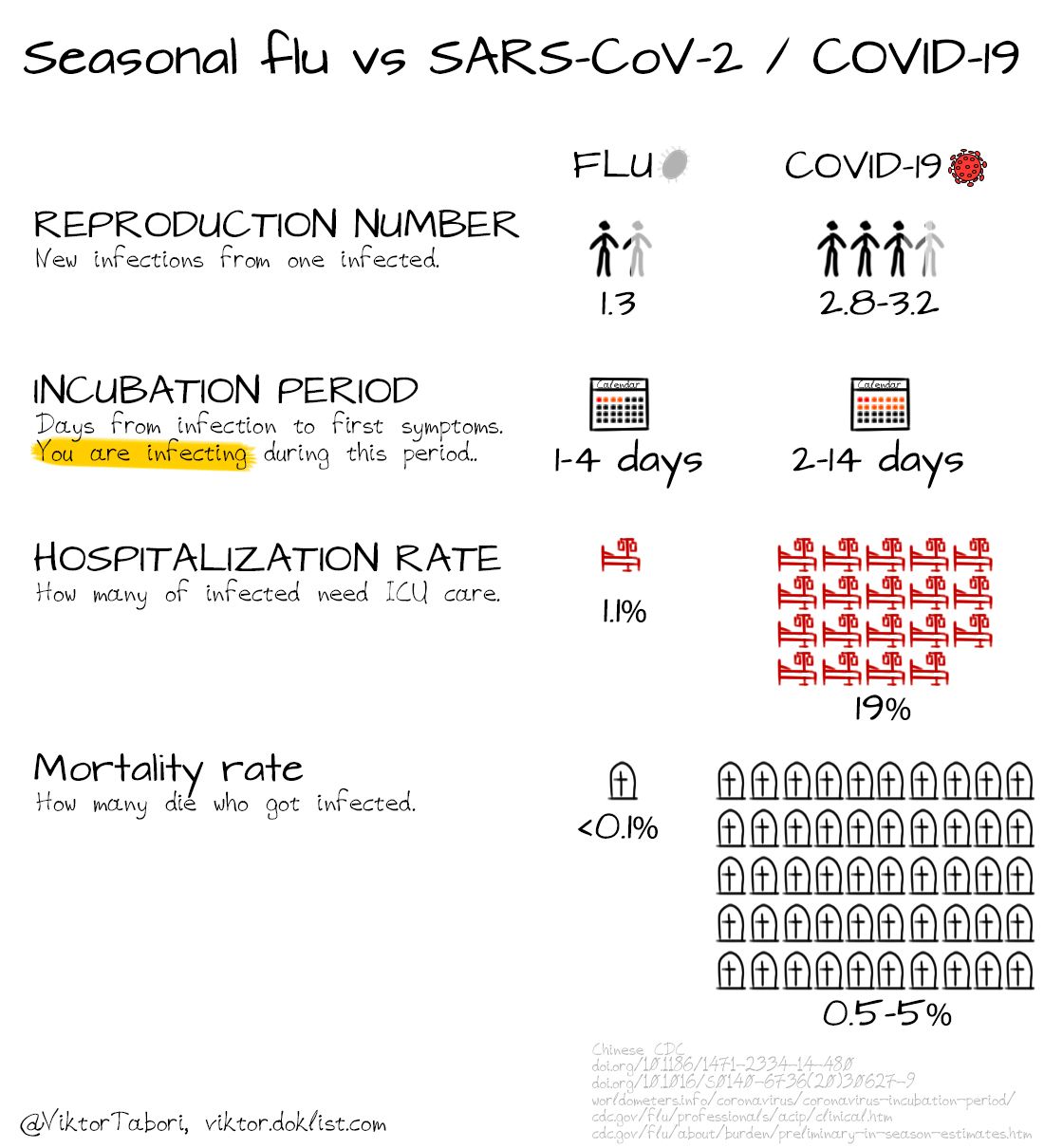
Fever is the most common symptom. If you experience difficulty in breathing, CALL your doctor or a COVID-19 hotline immediately. DON'T GO to the hospital to infect others or get infected. STAY HOME.
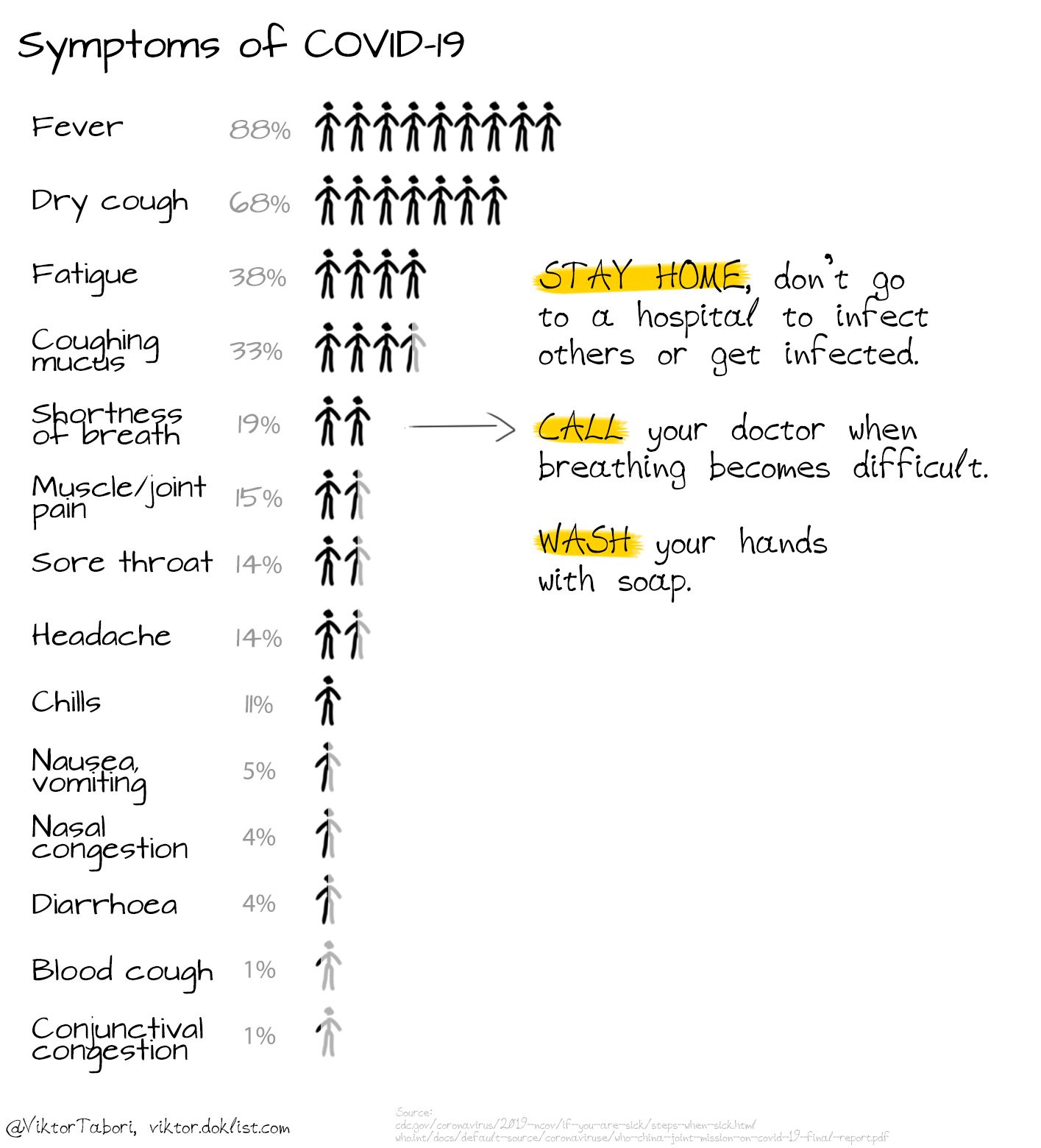
It is NOT just the elderly at risk, STAY HOME. Don't visit high-risk relatives. Don't play Russian roulette.
"[In Italy] the type of patient is changing, they are a bit younger, between 40 to 45 years old and the cases are more complicated" Luca Lorini, the head of anesthesia and intensive care at a northern Italian hospital, has said. independent, March 14th, 2020
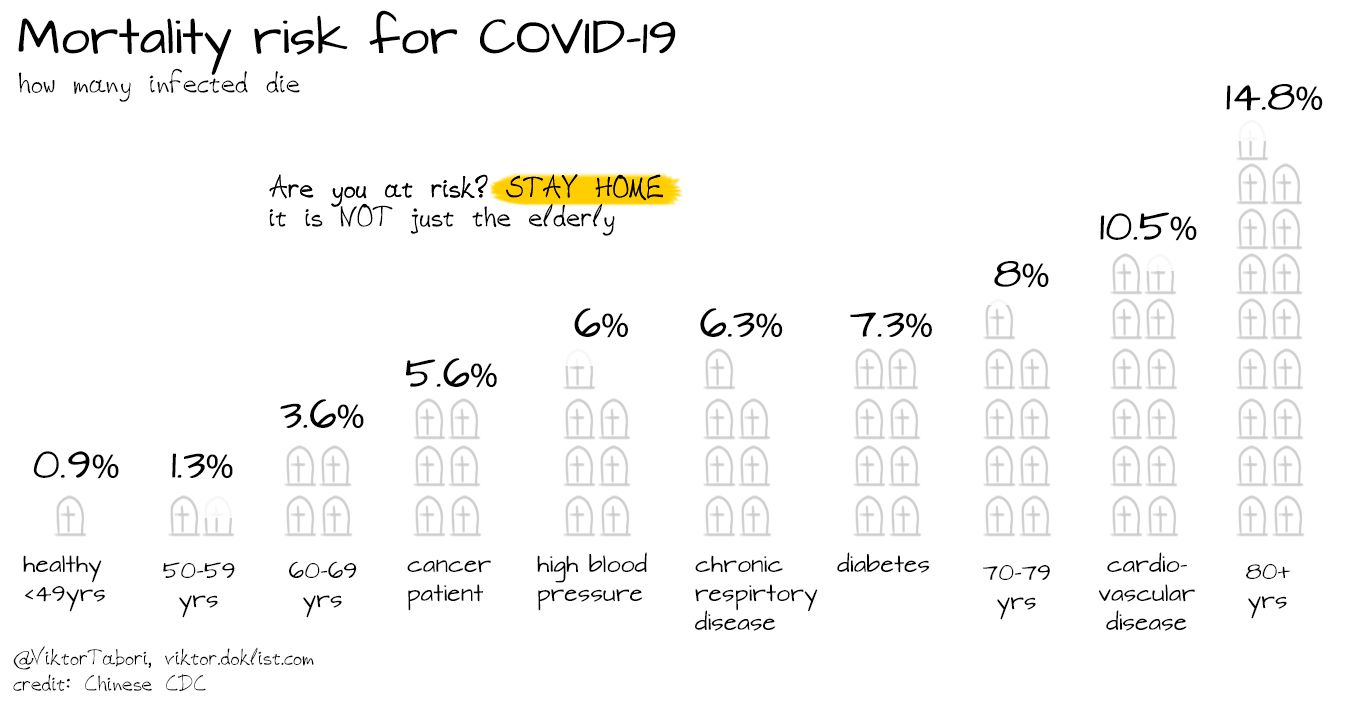
It takes 2 weeks for the first symptoms to worsen and get diagnosed (JAMA and China CDC data). Diagnosed numbers are showing the past on an exponential curve. There are several orders of magnitude more real infections than diagnosed. READ THE LAST SENTENCE AGAIN.
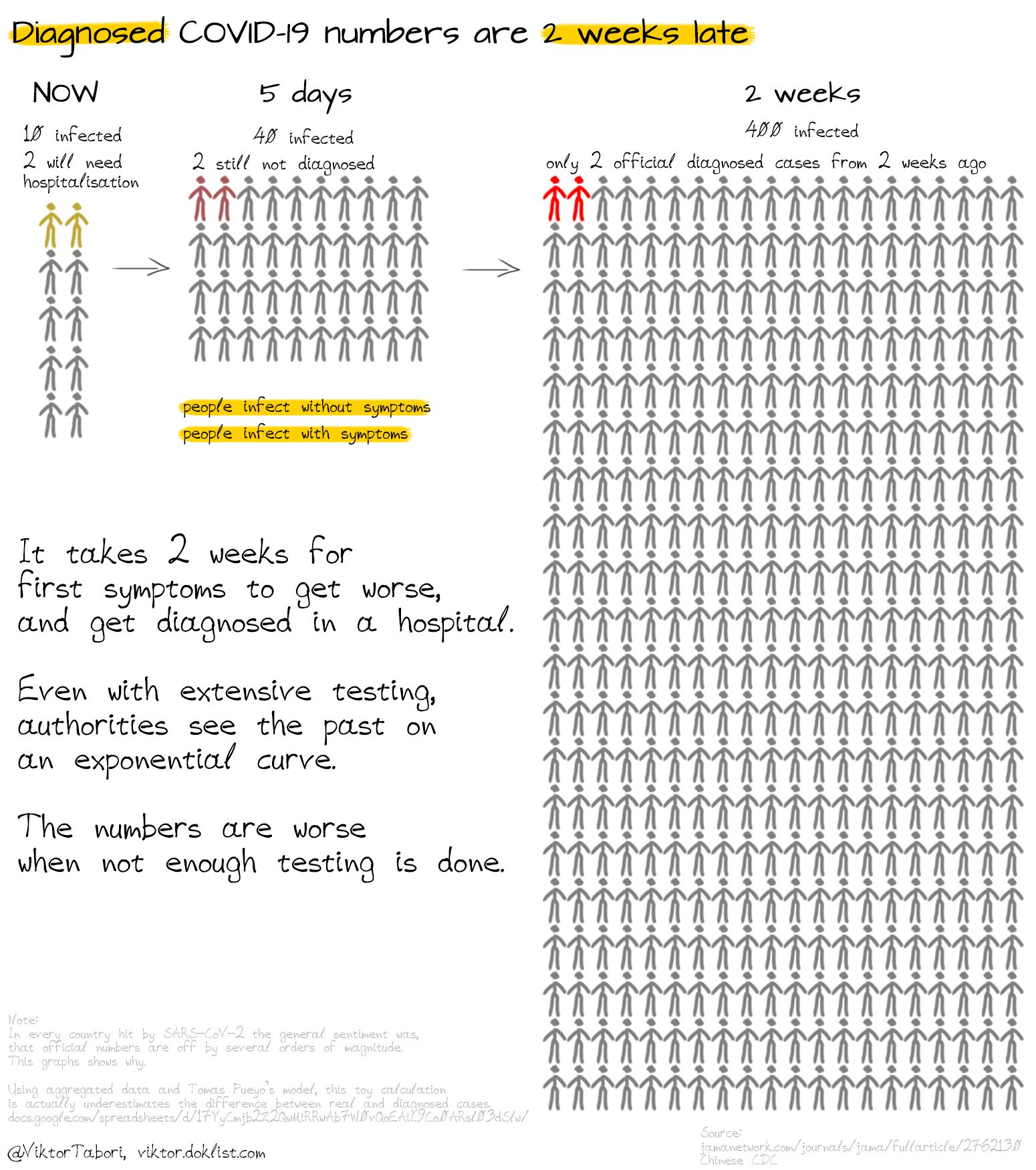
The virus survives on surfaces 8-72 hours (R). Nobody knows for how long can an infected person be infectious, but there is an indication that it can happen for 40+ days (R). WASH YOUR HANDS WITH SOAP. Or use 60%+ alcohol-containing hand sanitizer. You can go to the fresh air, just keep 2+ meters distance.
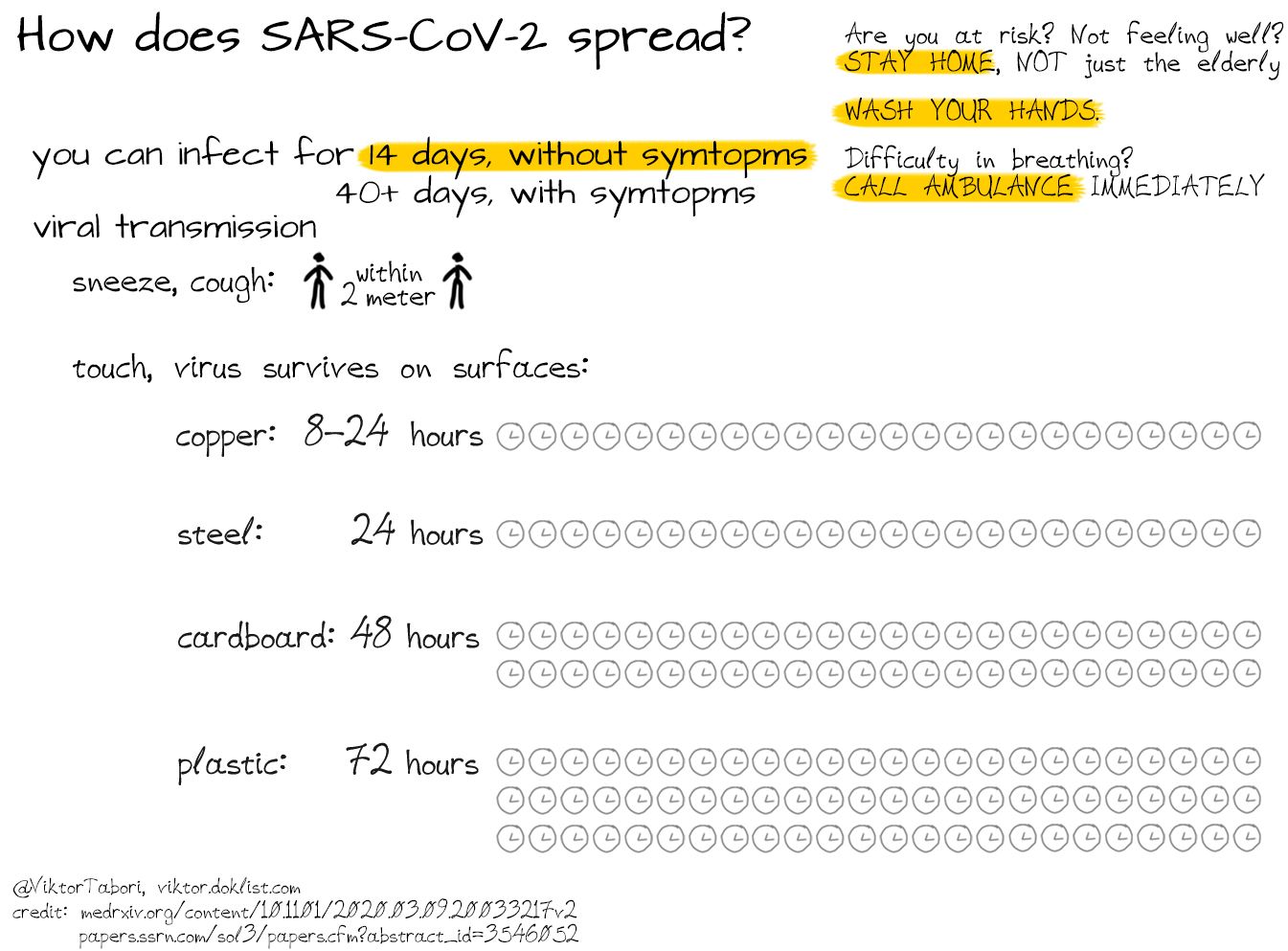
Summary of what you should know
SARS-CoV-2 (Severe Acute Respiratory Syndrome Coronavirus 2) is the virus, COVID-19 (Coronavirus disease 2019) is the disease caused by the virus.
In our mind, the word "virus pandemic" represents a benign virus mutating into an invisible super threat killing everyone, implying a 100% mortality rate. However, there is a tradeoff between lethality and spread, if a virus kills its host efficiently, then there is less opportunity to infect.
In reality, the mortality rate is not that devastating (how many die), but it spreads fast, and the hospitalization rate is 20%, meaning 20% of infected needs ICU care.
SLOWING PROGRESSION is CRITICAL, otherwise, healthcare systems get overwhelmed. 20% get infected, 20% of infected need hospitalization with breathing support, 25% of hospitalized are critical with organ failure (see: Diamond Princess, China CDC, Statista, Informationisbeautiful). Total exposure for a 10M territory means 2M infected, 400,000 intensive care unit beds and 100,000 serious life support. UCSF calculates with 0.5% overall mortality in the US in the next 12-18 months, which means 50,000 deaths for a 10M territory. To put it into context, Hungary is a 10M country with 127,000 deaths per year.
The mortality rate varies between 0.5% and 5% based on how fast a community reacts. If you don't feel like your leaders acted TOO EARLY and TOO AGGRESSIVELY, then you are probably in a region with a 5% mortality rate, rather than 0.5%.
We should protect healthcare workers from infection, otherwise, fewer firefighters can fight a flaming forest.
Infection: within 2 meters through droplets when someone coughs or sneezes, and through touch, since it also survives for 8-72 hours on different surfaces like plastic, steel, cardboard, copper (R).
People at risk have a MUCH greater risk of dying after infection:
- 80+ years: 14.8%
- cardiovascular disease: 10.5%
- 70-79 years: 8%
- diabetes: 7.3%
- chronic respiratory disease: 6.3%
- high blood pressure: 6%
- cancer: 5.6%
- 60-69 years: 3.6%
- 50-59 years: 1.3%
- no existing condition: 0.9%
- <49 years: <0.4%
- see: China CDC, Statista, Informationisbeautiful
Healthy young individuals are less likely to get seriously sick, but they are viral carriers, increasing the transmission rate.
People not in pristine health are at risk, NOT JUST THE ELDERLY:
"[In Italy] the type of patient is changing, they are a bit younger, between 40 to 45 years old and the cases are more complicated" Luca Lorini, the head of anesthesia and intensive care at a northern Italian hospital, has said. independent, March 14th, 2020
What everyone should do, especially if you are at risk or living with someone at risk, or you are NOT feeling well:
- ISOLATE, STAY HOME, don't visit your doctor
- WASH HANDS WITH SOAP for 20-40 SECONDS
If you have difficulty in breathing, CALL an AMBULANCE or your DOCTOR IMMEDIATELY.
DON'T be STUPID, have enough SLEEP, try to REDUCE STRESS (exercise? relaxing? music? creating? cooking? learning a new skill? new language? teaching through zoom?), drink enough WATER, don't stress your immune system with excess alcohol intake.
Washing hands with soap works wonders. Hand sanitizers containing at least 60% alcohol is also okay. It is STUPID to drink vodka with 40% alcohol content, or drinking methanol is even more so, as you are going to DIE as these 44 Iranians did. Drink WATER.
The EMOTIONAL toll is going to be high since every family has at least one person at risk, MAKE SURE you convince and teach them how to take care of themselves. Your healthcare system will get overburdened 3 weeks after the first death. It is going to be ugly to see the pictures and videos on social media, but we should keep focusing on what we can do, meaning ISOLATING those at risk and ourselves.
The virus doesn't care what you tell yourself:
- Heart disease: "It is common to have heart disease in our family, but I'm the exception, I'll do fine."
- High blood pressure: "I have sometimes high-blood pressure, but I feel ok"
- Diabetes: "My blood sugar is elevated, but the doctor said it is all right, I'm doing fine for my age"
- Smoking: "My great-great-grandfather smoked 7 packs of cigarettes a day and lived for 173 years, I only smoke 2 packs."
- "Our country's healthcare system is the most advanced in the world."
- "We are well prepared."
- The virus DOESN'T. GIVE. A. F**K.
- Don't play Russian roulette, REDUCE CONTACT, STAY HOME.
Let's be honest, nobody likes to admit that he or she is sick. We think that it is okay to have diabetes, it is okay to eat junk food, it is okay to be sedentary. But in reality, the low tide is here and most of us are naked. STAY HOME.
We can't be overly cautious when we face highly uncertain systemic risks. In school, you want to be right, smart, and get good grades, by definition you don't have skin-in-the-game, there is no downside. In life, you want to survive, and especially want the greater system to survive you are part of. STAY HOME.
This is NOT a crop disease for wheat or paper production. The virus is NOT mainly affecting working-age healthy individuals, so the production of toilette paper and food will be kept ongoing. When people rush the supermarkets, it will be restocked. Please keep in mind what YOU can do when panic hits.
First, you should make sure everyone around you is safe and educated about what is going on:
"When managing during a crisis first make sure that your people and the organization you are managing are going to be safe and then look for opportunities." - Ray Dalio
Then you should look for opportunities to create value:
I very frequently get the question: 'What's going to change in the next 10 years?' I almost never get the question: 'What's not going to change in the next 10 years?' - Jeff Bezos
In 10 years people are still going to want to connect with others, feel safe, have new experiences, and find meaning. Look at your own current frustrations and think of how could you eliminate them for others. Do you feel depressed in your home quarantine? Hold zoom breakfasts and invite people with similar interests. Learn a new language by talking to someone over zoom who is native. Teach someone your own language. Look at what frustrates you, and try to solve it for others. Find a challenging project which would benefit your local community and learn through doing. When there is turbulence, there is opportunity. We have to take responsibility. We can act.
Authorities SHOULD
- communicate transparently
- strongly break down on misinformation
- act promptly
- test extensively
- isolate cases
- enforce strong quarantine rules
- protect healthcare workers
- increase ventilator capacity (youtube)
Authorities SHOULD NOT
- believe “experts”, who want to wait and act gradually
- deny, hope, and rely on wishful thinking
If these actions don’t feel right for you, I hope till you get to the end, you will understand the gravity of the situation.
It is NOT the common flu
Admitting mistakes takes character, @BioBreakout is working for 18 years in medical practice, and he came around from being skeptical, to work in the frontline:
So far I've treated 5 confirmed COVID-19 patients requiring hospitalization, and currently have 14 suspected cases... and I can tell you that in 18 years of medical practice I've never seen anything like this
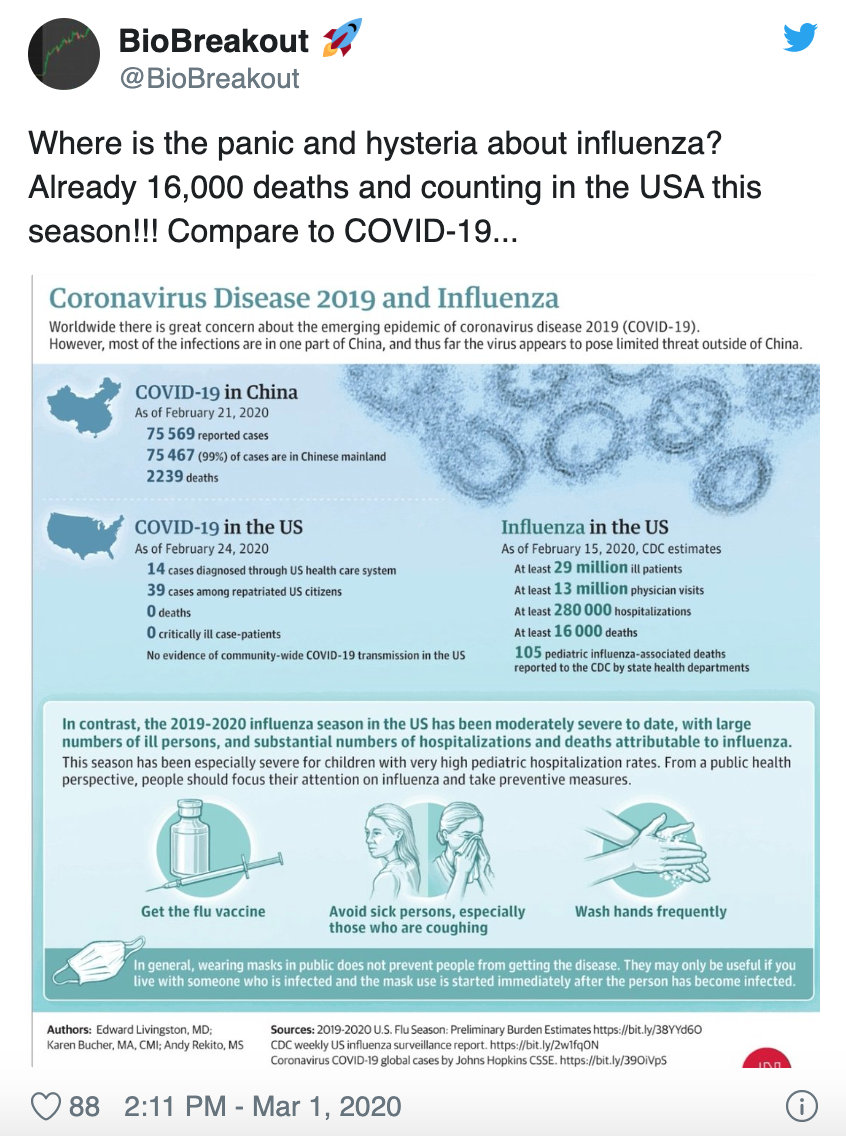
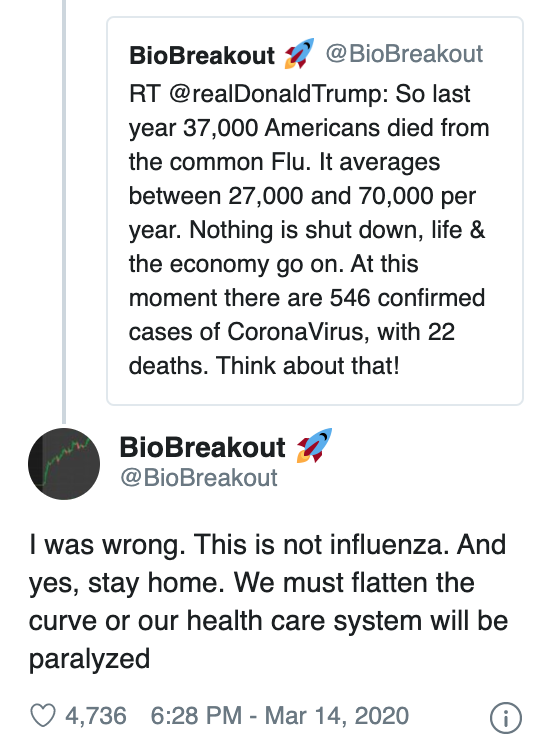
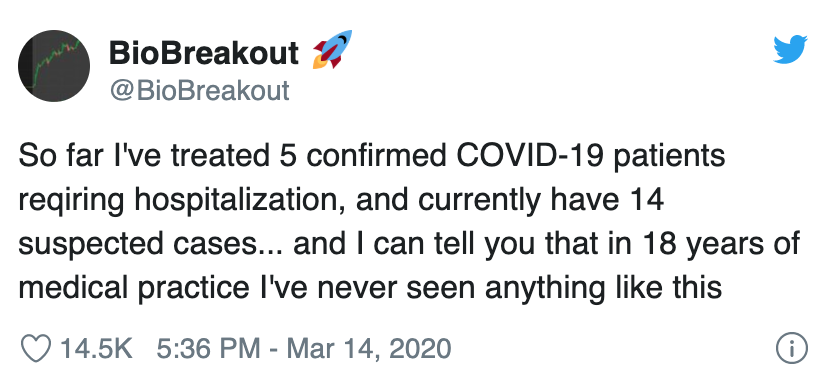
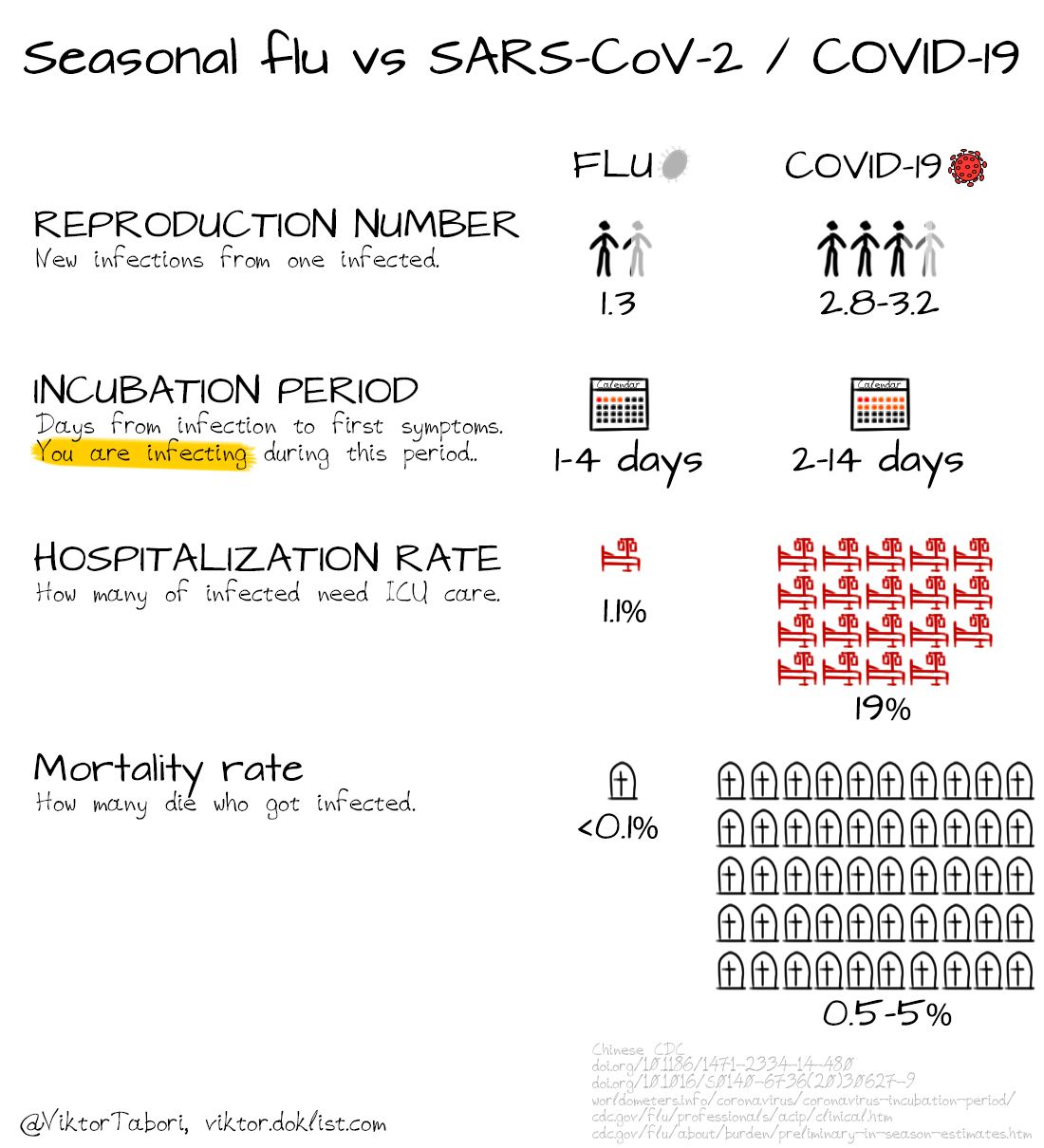
This section is the summary of Peter Attia's 4 Q&A videos (1, 2, 3, 4) and his interview with Peter Hotez MD and Paul Grewal MD.
Flu
The flu cripples the immune system and causes terrible fever, chills, weakness.
Elderly or immune-compromised people then can get a fatal bacterial infection.
COVID-19
The immune response isn't the critical part, COVID-19 directly leads to decreased blood oxygenation (possibly by disrupting heme in red blood cells thus hindering oxygen transport) and the sudden collapse of respiration. Sometimes to cardiac arrest. 10% of the cases have GI symptoms. It is a strange and highly non-predictable disease.
2.5-3.5 people get infected from a single individual, twice as much as with influenza, and the mortality rate is between 0.5%-5%, 5x-50x higher than for influenza.
Viral infection
To infect, any virus has to find a way into cells, and SARS-CoV-2 uses the Angiotensin-converting enzyme 2 (ACE2) receptor, similar to the first SARS virus, explained in this paper.
Immune function declines with age, thus the elderly have a hard time coping with an aggressive viral intrusion.
After infection, the virus takes over control and turns the cell into a factory to replicate itself.
Alveoli in the lungs
Alveoli is the smallest unit in the lung structure, where stretched-out thin cells (Type 1 pneumocytes) are responsible for exchanging CO2 for O2 (R).
Type 2 pneumocytes (AT2 cells) produce and secrete surfactant, making breathing possible (R).
Surfactants and soap bubbles
Soap is a surfactant, it helps to decrease surface tension when added to water, thus we are able to blow bubbles. If we remove the surfactant, bubbles can't form anymore.
Respiratory collapse
When AT2 cells are busy churning out copies of the virus instead of producing surfactant, the alveoli can't open up, and the breathing collapses.
It seems like the virus is disrupting oxygen transportation as well by kicking out heme from red blood cells (R).
IF YOU HAVE DIFFICULTY IN BREATHING, IMMEDIATELY CALL YOUR DOCTOR.
Diversity of ACE2 receptors
ACE2 receptors are expressed in diverse cell types (lung, kidney, blood vessels, heart, GI tract), which makes the disease very unpredictable.
Cardiovascular disease
ACE2 receptors are expressed in the heart, so a pre-existing heart disease + a high viral load can lead to a cardiac arrest since already compromised cells in the heart get taken over by the virus.
High blood pressure
For high blood pressure more ACE2 receptors are expressed, thus there are more sites for the virus to bind to.
Giving someone ACE2 inhibitors as a new drug leads to increased ACE2 receptor expression, and seems to worsen the disease.
Chronic respiratory disease and smoking
There is LESS respiratory reserve, so the risk of collapse is higher.
Diabetes
Type II diabetes is a well-known risk for high blood pressure, cardiovascular disease or cancer. Interestingly, Type I diabetes also seems to be a significant risk factor.
Children and teenagers
They can get infected and become viral carriers, but they don't seem to get hit hard by the disease. With age adaptive immunity and naive T-cells decrease [R], which is a highly speculative answer at this stage, but there was a small trial turning back the biological age clock in humans by rejuvenating the Thymus (nature), and age is a strong factor in COVID-19 mortality risk.
Possible treatments for COVID-19
Vaccination is extremely tricky, new vaccines should be treated carefully to avoid situations like the 1960’s Respiratory syncytial virus (RSV) vaccine, where vaccinated people got worse. Repurposing existing medications are more promising.
I recommend these - two podcasts if you are interested, where Peter Attia talks about potential treatments by antibodies from recovered patients, Kaletra and Chloroquine, and Remdesivir which was repurposed from Ebola clinical trials.
Main risk: overwhelmed healthcare system, overworked healthcare workers
Tomas Pueyo did an epic analysis of the Wuhan data, I strongly recommend reading it.
There is a 2-weeks lag between official case number and reality, in spite of the strictest effort, because first symptoms become worse after 11 days, so people get diagnosed 2 weeks later.
The process is exponential: after reaching 400 newly diagnosed cases, Wuhan got completely closed off. Their real case number was 12,000. 30x more.
Authorities always see the past on an exponential curve. READ THIS LAST SENTENCE AGAIN, this is no joke, a few days matter a LOT.
When Wuhan got closed down, the real infection rate instantly dropped, but authorities kept seeing increasing numbers for the next 11 days because of the lag.
Why acting early matters?
The underlying process is extremely non-intuitive and non-linear. Closing down on the 20th day vs 21st day could have meant 40% fewer infections.
"If we reduce the infections as much as possible, our healthcare system will be able to handle cases much better, driving the fatality rate down. And, if we spread this over time, we will reach a point where the rest of society can be vaccinated, eliminating the risk altogether. So our goal is not to eliminate coronavirus contagions. It’s to postpone them." writes Tomas Pueyo.
What individuals can do?
Self-isolation. If you are at risk or living with someone at risk, this is the most important thing you can do. If you are healthy and young, you are unlikely to be affected physically, but it is going to affect you emotionally through friends and family members who are at risk.
Wash your hands with soap for 20-40 seconds, it destroys the fat-membrane of the virus, just like you wash off fat from your hands with soap. If washing is not practical and you have hand-sanitizer, use it by any means, but SOAP IS DOPE.
Alcohol containing hand sanitizers only work if they have 60%+ alcohol content.
You DON'T need alcohol or antibacterial agents, traditional soap works wonders, read how chemist Palli Thordarson explains it:
3/25 Disinfectants, or liquids, wipes, gels and creams containing alcohol (and soap) have a similar effects but are not really quite as good as normal soap. Apart from the alcohol and soap, the “antibacterial agents” in these products don't affect the virus structure much at all. - @PalliThordarson
Proper hand-washing technique:
What individuals shouldn't do?
"It is remarkable how much long-term advantage people like us have gotten by trying to be consistently not stupid, instead of trying to be very intelligent." - Charlie Munger, the business partner of Warren Buffet
A friend of mine told me that his job is stressful, so he can't sleep enough, and he gets the flu every month. Now he drinks a special cocktail to strengthen his immune system. I told him first he should solve the underlying issue: sleep and stress. Before thinking about what kind of additive you should pour into your car, first make sure you are NOT burning down your engines.
Try to avoid being STUPID:
- sleep deprivation: make sure you sleep enough
- stress: exercise, music, relaxation, sauna, creating, reading
- junk food: while working from home you have less pressure to eat quick, be mindful
- alcohol: alcohol is NOT enhancing your immune system, please consider how much or whether you drink at all, a vodka with 40% alcohol content won't do any good to you
- dehydration: DRINK enough water
Emotional pain of COVID-19
The threat is invisible, which makes it terrifying. My main goal with this summary is to mitigate this aspect of emotional pain.
It is going to affect every family, everyone has old relatives and friends with health conditions.
People will feel lied to, since in reality there are exponential more cases than the official numbers, even in face of extensive testing, because of the 2-weeks lag between first symptoms and diagnosis.
Being locked up at home is extremely depressing, while social media keeps us updated, and sirens are constant in the background.
Financial insecurity is a current reality for masses losing their jobs without savings.
The disease progression becomes extremely vivid on social media.
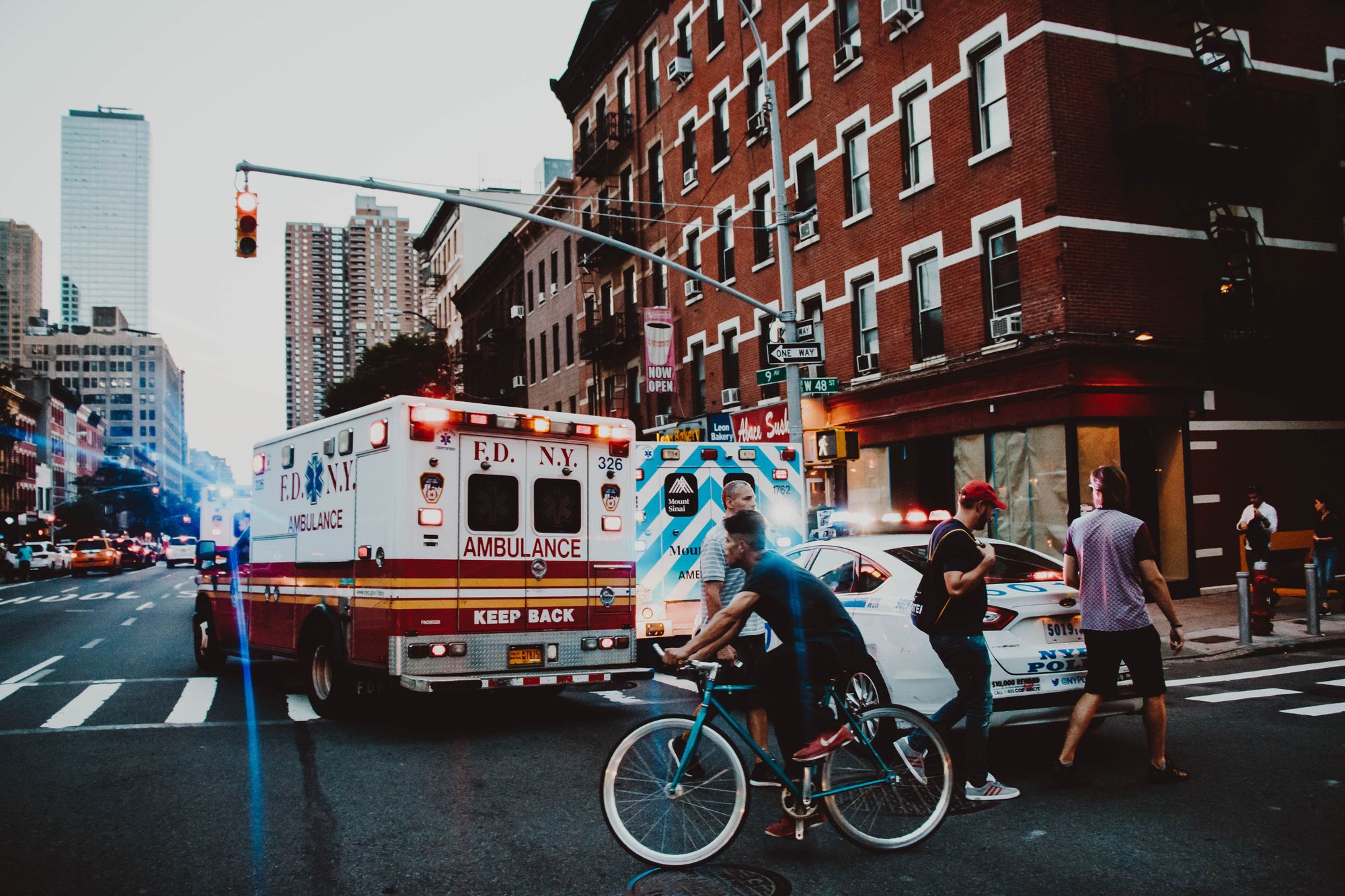
Learning from other countries
There are only two kinds of countries:
1) which are prepared after experiencing the lethality of SARS in 2003
2) which will be prepared the next time
Worst practices of unsuccessful countries
Italy
Italy is a high-risk society
- Old population
- high prevalence of smoking (24%, source)
- healthcare is close to max capacity (estimated 2,500 ICU bed capacity out of maximum 5,200 ICU beds)
Doctors decide who get oxygen thus live
Lombardy is the most developed part of Italy, with great healthcare. Just three weeks after the first death they operate at 200%, using 1000 ICU beds out of maximum of 5200, and doctors already have to decide who gets oxygen thus live (March 13th).
"Anesthetists – despite them playing it down a little bit on the media – have to choose who they attach to the machine for ventilation, and who they won’t attach to the machines" - Euronews, March 13th
Wait long enough, and in this case, we talk about weeks, and an exponential process always wins over a linear process, meaning increasing ICU bed numbers won't cut it in the face of this exponentially growing epidemic. We have to slow down progression as much as possible. THIS IS WHY YOU SHOULD STAY HOME.
Healthcare workers feel abandoned
Monica Trombetta, a nurse working for the same trade union in Como, told Euronews that “we're very tired and afraid. Government decrees change every day. Personnel does not have clear guidelines for dealing with this new virus and feel a little abandoned – not by our hospital, but it’s just as a general feeling. Nurses are afraid to go home and potentially infect their relatives." - Euronews
20% of healthcare workers get infected
"Health-care professionals have been working day and night since Feb 20, and in doing so around 20% (n=350) of them have become infected, and some have died." COVID-19 and Italy: what next?, The Lancet
Doctors and leaders die
3 weeks after the first death Italy went under lockdown banning gatherings (BBC), and Roberto Stella, 67, who led the fight against the epidemic died from respiratory failure due to the virus (metro.co.uk).
Patients are alone in Emergency Room, and can't say goodbye
"I pulled out the phone and called her on video. They said goodbye. Shortly after she left. By now I have a long list of video calls. I call it the farewell list. I hope they give us mini iPads, three or four would be enough, not to let them die alone." - Euronews
Intentional murder if an infected isn't self-isolating
There is a strict curfew and coronavirus patients who refuse to self-isolate face intentional murder charges in Italy with up to 21 years in prison (Metro.co.uk).
"Under the government’s emergency decree all non-essential travel is banned and people have to carry around forms that justify their reason for being on the streets. The interior ministry said police had booked some 2,162 people during the day for violating the order. Those found guilty of infringing the rules face up to three months in prison and a fine of up to €206." - Metro.co.uk
The lockdown came late
Jason Van Schoor explains how the process starts out slow, then ends up in complete disaster very quickly:
Lockdown came a full week after passing 400 new cases per day, at which stage Wuhan was already completely closed.
If the curfew was effective, we know that cases and death will rise exponentially for the following 11 days, till March 22nd, when it will turn down, just as in Wuhan.
On the other hand, if we use Tomas Pueyo's model and the current death toll (4825 deceased on March 21th), then we get 4 million real cases as of today. Considering the exponential nature of this epidemic, and the fact that the measures were weak compared to Wuhan, the worst-case scenario seems to be inevitable. It means 12 million infected people, of which 2.4 million would need intensive care, where Italy has 5,200 ICU beds altogether.
England
England has a 5000 ventilated beds (Guardian), and judging their actions, they are well on their way to become Lombardy.
Not "overreacting" and playing Russian roulette by relying on "experts"
Experts: school closures would be difficult
"Experts also believe it would be difficult for school closures to work in practice, as children off school would end up socialising anyway or spending time with grandparents, who would be worse-affected by the virus. Schools will be asked to stop foreign trips." - Guardian
Vs reality: the UK should have acted 5 weeks ago
"It’s a joke when they put up people to say they are really on top of it and if it spreads at a community level the NHS will cope, it’s always coped. The hospitals are full at the moment, A&Es are full, beds are full, intensive care is full.
[...]
Right at the beginning of February, they [Hong Kong] adopted a total approach to this, which is what we should have done five weeks ago ourselves. They took a decision to work to three principles – of responding promptly, staying alert, working in an open and transparent manner." - Guardian
Official UK guideline for how doctors should decide who gets critical care
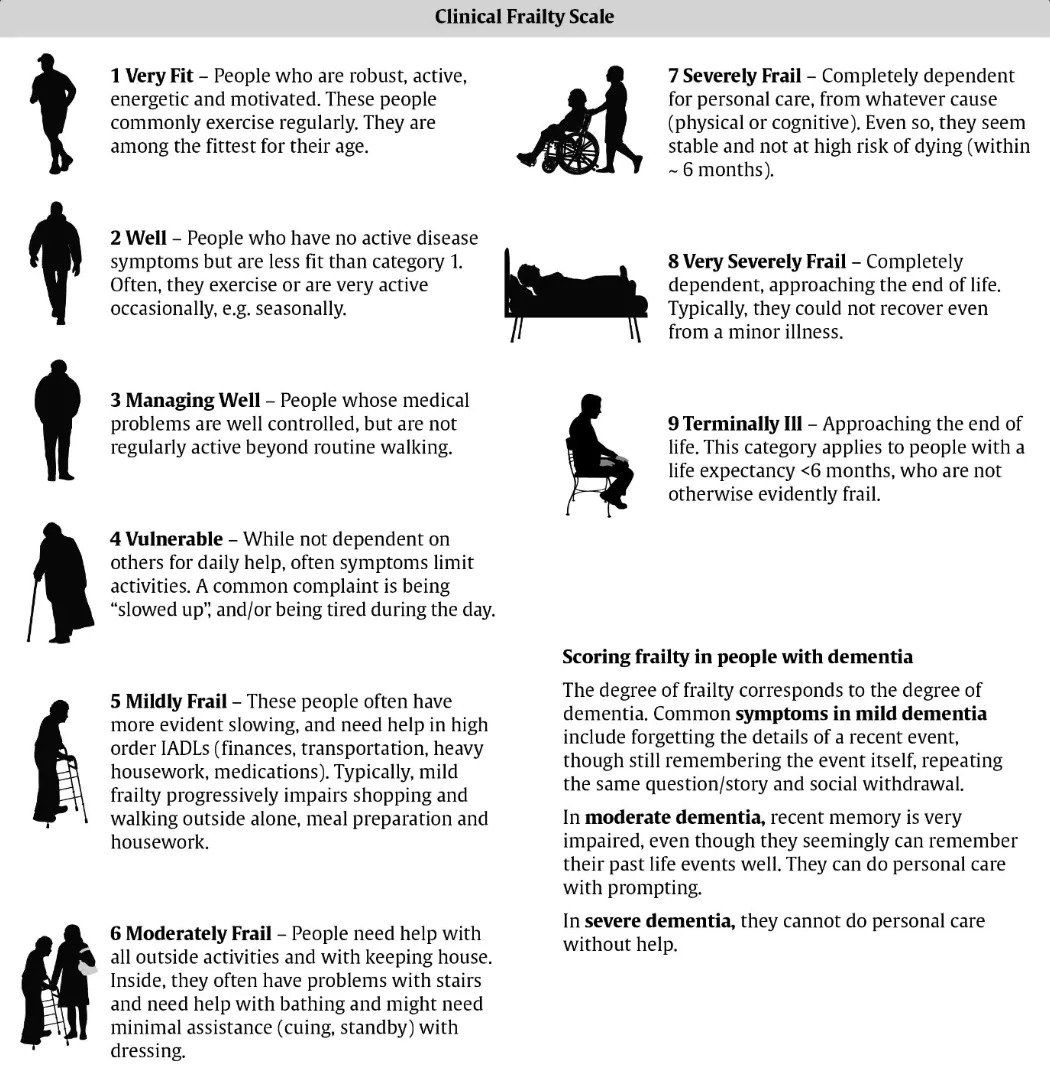
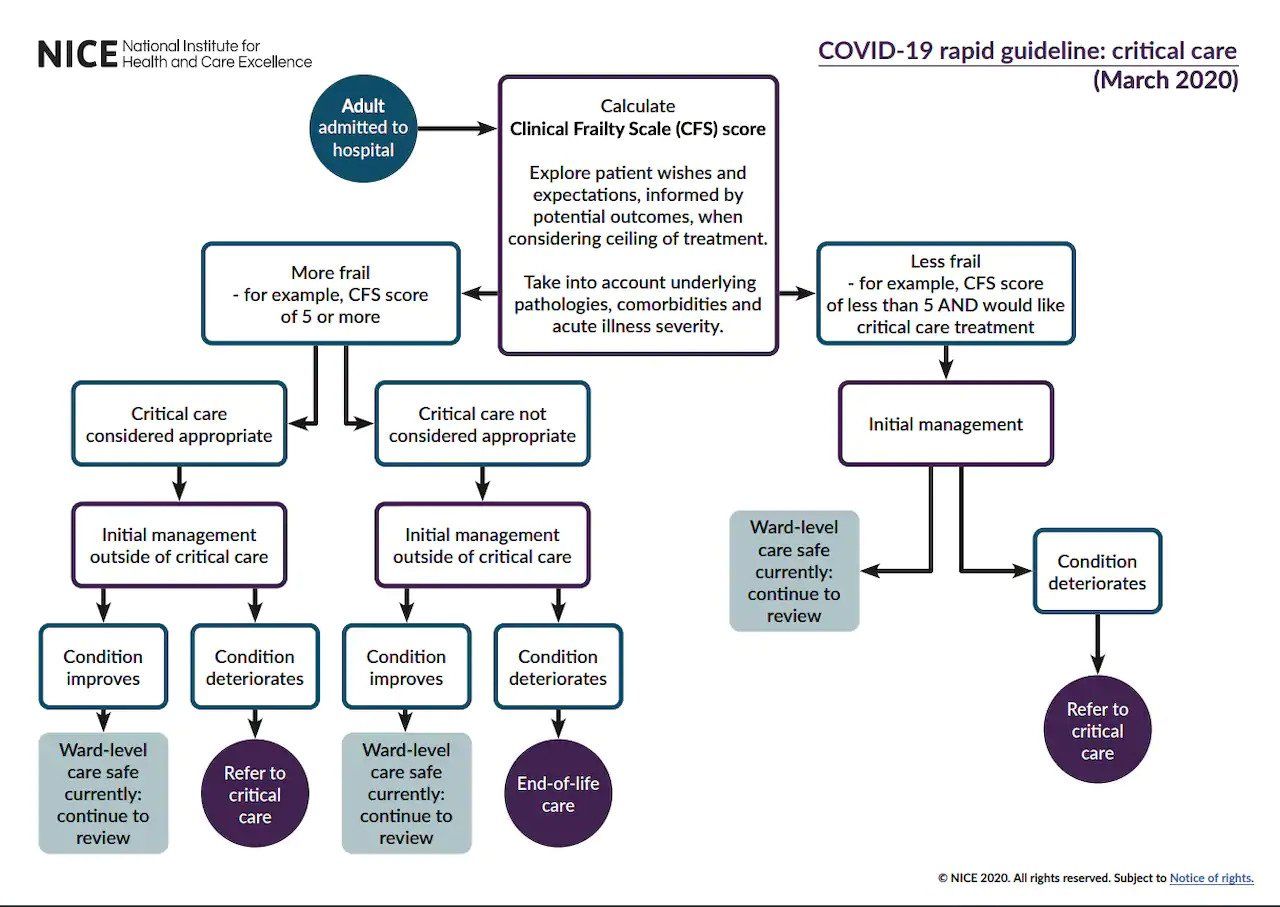
US and Japan
Not enough testing
USA developed its own test for COVID-19, which was faulty, so practically no testing was done until early March, then it was still not enough.

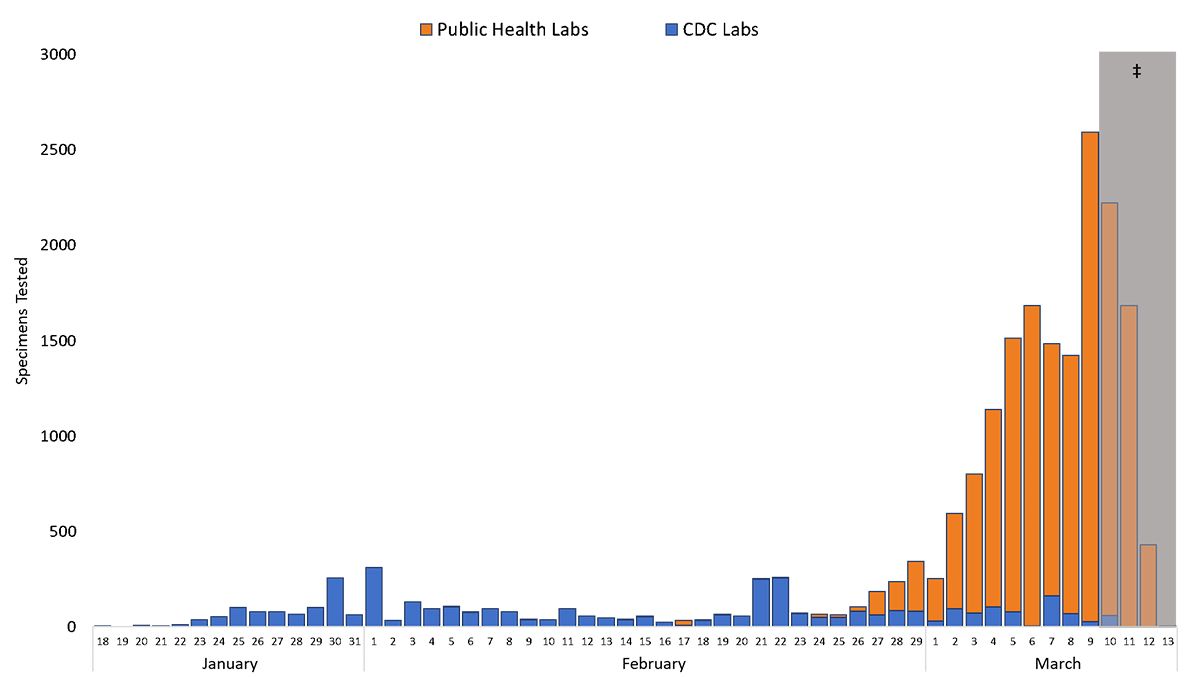
As former FDA Commissioner Scott Gottlieb said, to avoid the path of Italy, aggressive testing, quarantine, and travel ban would be needed.
Political and economic motives
30% of Japan's population is over 65, meaning they are at high risk. Still examining the above chart from Vox it is apparent that Japan is running the lowest amount of tests among seriously exposed countries. Why? 2020 Tokyo Olympic Games.
Risking the lives of a community you are responsible for is not just morally wrong, but also stupid. You can't stop this pandemic, and for that matter, neither the financial meltdown, all we can do is SLOWING it DOWN to buy time for the healthcare system, and minimizing casualties.
South Korea
South Korea was right behind the worst countries, but they also do the MOST testing among all the countries.
Super-spreader patient 31
Until 30 patients they had everything under control, but then one person turned out to be a super-spreader, infecting thousands of people in a religious gathering, and they pay the price of this one instance (Reuters)
So luck plays a huge role, and it is a question of how lucky do we get as humanity or just the US for that matter.
Best practices of successful countries
Hong Kong took the threat seriously early on
"Hope is not a strategy," says Ryan, who is an epidemiologist. "We are still very much in the up cycle of this epidemic." - NPR
Just two days after the first cases appeared, the school holiday was extended, and serious health checkpoints were implemented at busy railway stations. After one week civil servants were working from home.
"Hong Kong, which began testing in January and has been right up against the epicenter of the global outbreak, had only confirmed 126 cases through March 10. On that same day the U.S. reported twice that number for the previous 24 hours." - NPR
Singapore traces and isolated everyone meticulously
Taiwan
Only 130km from the shores of mainland China, Taiwan was expected to hit badly by COVID-19, but they successfully contained it with strong early actions (https://doi.org/10.1001/jama.2020.3151.).
Leveraging technology
- Integrated health insurance, immigration, and customs databases.
- Created real-time alerts during clinical visits to identify new cases based on travel history.
- Re-screened those with negative influenza test in the past, they caught 1 case out of 113 with it.
- Classified individual risk by travel history from past the 14 days.
- Low-risk citizens got QR codes in SMS for faster immigration clearance.
- High-risk citizens' compliance with home-quarantine was tracked by mobile location data.
Transparently educating the public
- A toll-free number could be called to report symptoms and cases.
- The vice president - a prominent epidemiologist - gave regular announcements online about when and where to wear a mask, the importance of handwashing, and the danger of hoarding masks which could make frontline workers exposed.
Fining misinformation for up to $100,000
For example, a citizen was prosecuted by spreading rumors that cyanide can ward off the virus.
Protecting those working in the first-line
With 24M inhabitants, they stocked up 44M surgical masks, 1.9M N95 masks, and 1100 negative pressure isolation rooms. Also, they promptly scaled up surgical mask production from 4 million to 10 million per day.
Slovakia
Slovakia acted fast, and as a neighboring country to Hungary, it is interesting to see their decisions.
Nothing to lose politically
Peter Pellegrini's party lost the parliamentary elections two weeks before the first case appeared on March 6th, so in his remaining days, he had nothing to lose (R).
Strong leadership and transparent communication
Peter Pellegrini, as prime minister, is leading the fight against the pandemic, holds daily news conferences, answers direct questions, and decides quickly. He offered government aircraft to procure 30M surgical masks and other medical supplies.
All borders and international airports were closed within 1 week. Hospital visits were banned, and everything is closed down besides essentials like supermarkets and pharmacies. Without face masks, people can't use public transportation or step into a supermarket.
There are dedicated quarantine hotels if someone can't self-quarantine. Leaving a quarantine is fined 1600 euros. There is an active media campaign to promote staying home.
Mobile application and location data
Slovakia developed an application to send notifications when we approach an infected area, and also notifies people we have crossed paths in the last 2 weeks if we turn out to be infected.
Mobile carriers have to provide location data to monitor social mobility and make decisions about potential local interventions.
Citizens compliance
The streets in Bratislava are empty, people understand the gravity of the situation.
The two endgames
We see the mistakes and best practices of other countries, but how is this going to end?
Option A) Controlled isolation until a cure is found which may take up to a few years
Regions acting swiftly and firmly have the option to keep on strongly controlling their borders and the infection, while a cure is invented.
This may imply a higher economic cost, but significantly lower death count, as we have seen in the case of Wuhan (3500 deaths for 60M people).
Option B) 4% die
"...governments are not trying to really win a war against this invisible enemy. Instead, they are trying to contain it and fight a war of attrition to triage parts of our society so that a massive social rebellion does not occur when hospitals collapse. What this means is that the public is not being told how long they will likely be locked down or how long the crisis will continue." - The Jerusalem Post comments on an Imperial College London report modeling the fight going on for 18 months
As we saw in the visual summary, Italy is well on its way to reach total exposure with 2.4M needing ICU care, while they only have 5,200 ICU bed capacity.
In this worst-case scenario, the 4% of society who is susceptible won't be able to get care. This is 2.4M deaths for 60M people. 400k for 10M.
One person in Iran dies every ten minutes from COVID-19 Iran's health ministry, Kianush Jhanpur tweeted on March 19th:
مطابق آخرین داده ها، تقریبا هر ساعت، ۵۰ نفر در ایران به #کووید_۱۹ مبتلا می شوند و ایضا هر ده دقیقه، یکنفر جان خود را در اثر پیامدهای ناشی از ابتلا به #کرونا از دست می دهد.
— Kianush Jahanpur (@drjahanpur) March 19, 2020
با لحاظ این اطلاعات در مورد سفر، تردد، جابجایی و دید و بازدید نوروزی و ... آگاهانه تصمیم بگیرید ...
It is extremely hard to write down this option, but it had to be written down, so people could act while they have the choice. STAY HOME and EDUCATE
When do we get back to normal?
Nobody knows, but given the healthcare crisis, and the imminent global economic crisis (ft.com "Ford borrows $15.4bn to manage plant shutdown", last fall IMF was already pessimistic about a potential correction without the pandemic), and the resulting emotional trauma, I wouldn't bet too much money on it going away quickly.
This is what my friend Simon O'Regan, the Product Innovation Director at Mastercard, sent me on March 7th:
Sequoia just sent out a 'Panic like it’s 2009' email to their founders and CEOs (AirBnB, DoorDash, Evernote, Instacart, Klarna, Stripe, et al.). The general gist is that we should expect a drop in business activity, softening demand and supply-chain disruptions. This is the first time they’ve sent an update like this since their now-famous 2008, ‘RIP Goodtimes’ presentation.
Extract
Having weathered every business downturn for nearly fifty years, we’ve learned an important lesson — nobody ever regrets making fast and decisive adjustments to changing circumstances. In downturns, revenue and cash levels always fall faster than expenses. In some ways, business mirrors biology. As Darwin surmised, those who survive “are not the strongest or the most intelligent, but the most adaptable to change.”
Important unknowns
Does the disease leave permanent damage? Meaning those who recover are in the same state as those who never got it?
Do we get permanent immunity or is it like seasonal flu? After 2.5 months of shutdown, Hong Kong has started to open life back on the streets but they fear a new wave of infections imported back from Europe and the US.
We know it is mutating, which doesn't imply anything at this stage:
My experience in Hungary
Price of misinformation
Around March 10th a rumor started to spread that authorities are going to close Budapest, the capital of Hungary. Although authorities refuted the information, quite a lot of my friends went to the countryside in fear of getting locked down in Budapest, thus potentially speeding up the spread throughout the whole country.
We have seen in South Korea that speeding up the infection can have a devastating effect, which classifies as intentional mass murder in my playbook.
Price of lack of clear communication
My grandmother lives in a nursing home, and anyone can send in packages. She told me, they can get those packages after 2 hours waiting period, even though it is known that the virus survives for 8-72 hours on different surfaces (R). Unfortunately, nobody sent the memo. She was also confused about whether she can go out for fresh air. I told her that it is okay to be in the open air as long as she keeps a proper distance from others and that she should wash her hands with soap for 20-40 seconds after returning inside. It shouldn't be our job, but WE SHOULD TAKE RESPONSIBILITY.
Holiday towns are full
People flocked to holiday towns to avoid being stuck in bigger cities, which probably further accelerated the spread through the country (R). In the face of highly uncertain environment, herd behavior rarely helps.
Employer negligence
My mother has a friend, who's request for home office was rejected on the week of March 9th. She has a kidney transplant, thus an artificially weakened immune system to prevent organ rejection.
People don't believe in the pandemic until they see it, then it is already too late, while they risk other people's lives along the way.
Pain of financial insecurity
Dentist friends telling me, that colleagues are crying because of not being able to pay rent, since they don't have savings. The grim reality is that most people don't have savings.
Young citizens comply, there are too many elderly on the streets
I still see lots of old people on the streets in Budapest on March 21st, it seems like they won't take the situation seriously until it is too late.
Early curfew with 11 deaths, dedicated shopping time for the elderly
Curfew is effective from March 28th, supermarkets are open from 9am till 3pm, and before noon only citizens above 65 can go shopping.
Hungary as Lombardy
"First divide [Italian death count] by 6 because of population difference, then multiply by 6 because our healthcare is 6x worse, then multiply by 2 because we are 2x as sick and you get the Hungarian numbers for the next 2 weeks." - Hungarian surgeon friend comparing Italian and Hungarian chances on March 20th
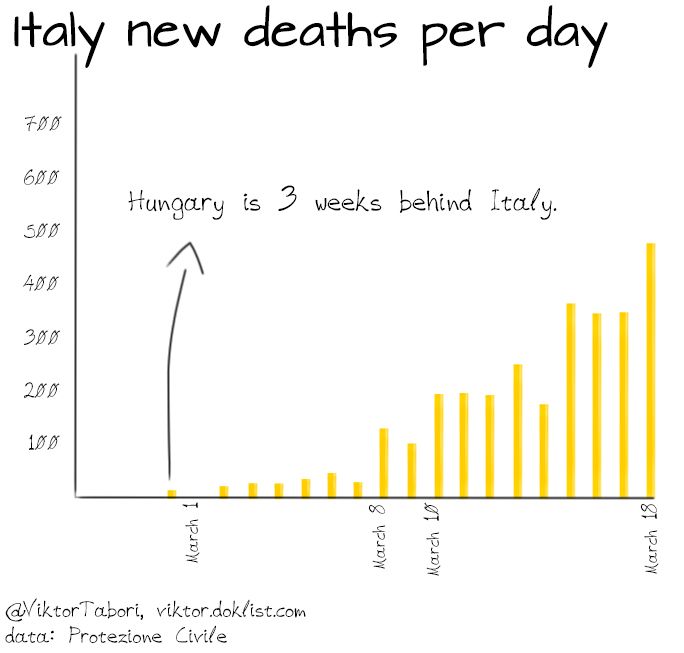
Hungary and Lombardy both have 10M inhabitants, the same rate of smoking, and similar age distribution.
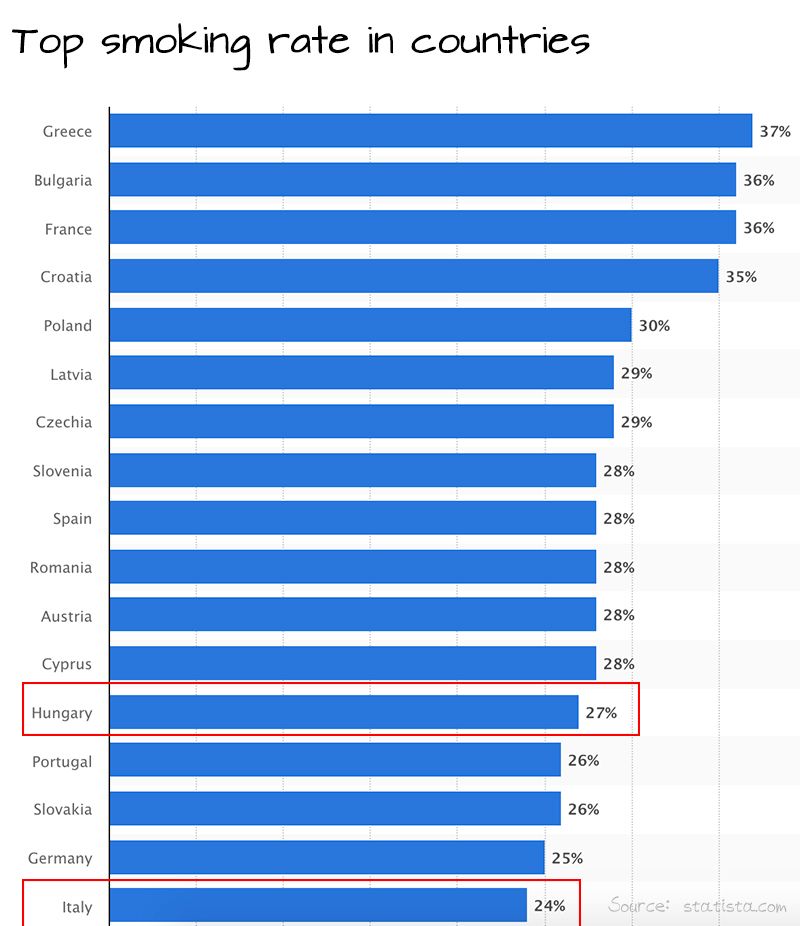
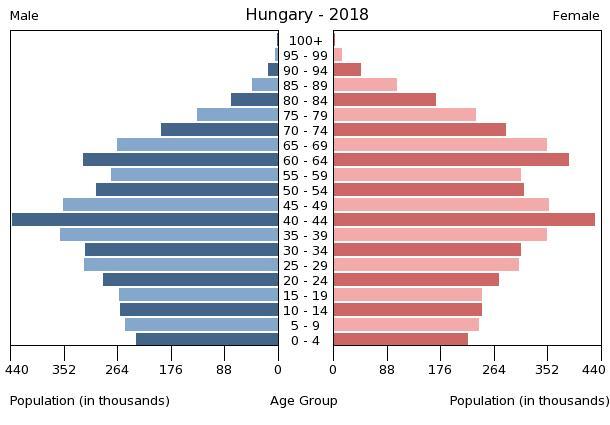
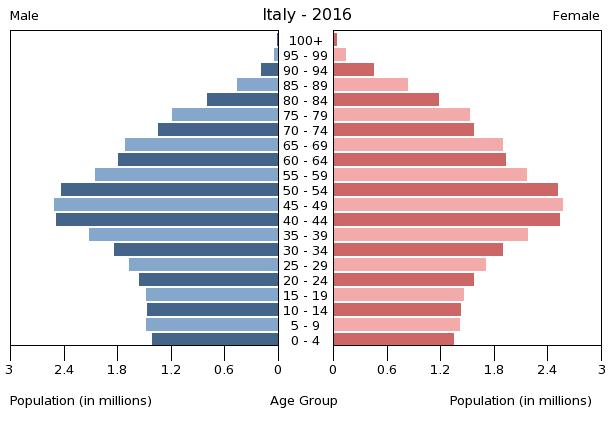
Unfortunately, Hungary fares extremely bad on health and healthcare front: out of 127k deaths per year, 50% dies in cardiovascular disease, and 25% in cancer, both of which are serious risk for COVID-19 mortality:
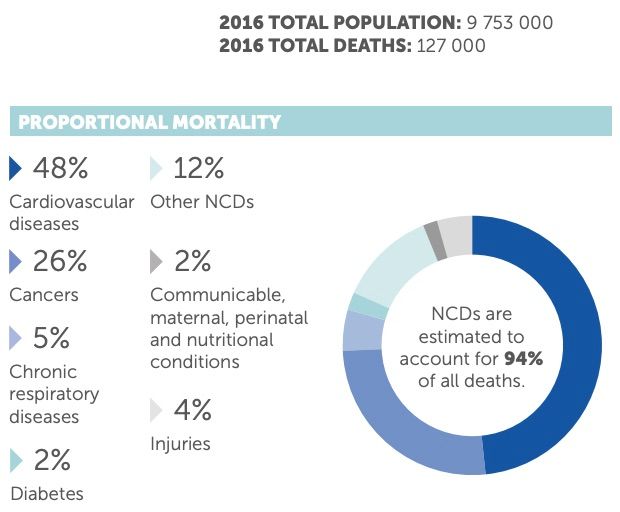
Hungary only has 189 ICU beds dedicated to the disease (as of March 7th, 2020, hirado.hu), but even if we had 5x more, it would save a few days at maximum without decreasing the speed of spread.
What we can do as citizens is to STAY HOME and EDUCATE our families about ISOLATION and PROPER HAND WASH WITH SOAP.
We should keep in mind amid the panic, that NOT EVERYONE will get infected, 4% of exposed will need ICU care, which won't be easy, but we will win over this disease if we are vigilant.
If there is demand, production will keep ongoing, it is in everyone's best interest to get the economy back on its feet. Look for opportunities to create value around you.
SHARE this article, and tell why others should read it.
Thanks for thoughtful feedback, suggestions, and discussions: Dr. Mihály Kertész, Máté Wohlmut, Will Mannon, Dr. Bence Mészáros, Tomi Mester, Syed Iqbal Simnani, Salman Ansari
